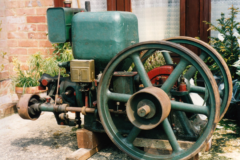Wood-fuelled tractors
Posted by Chris Graham on 4th September 2020
Wood-fuelled tractors sound like an excellent, cost-effective idea but, as Mike Williams explains, the practical results from those who tried it, weren’t quite so encouraging.
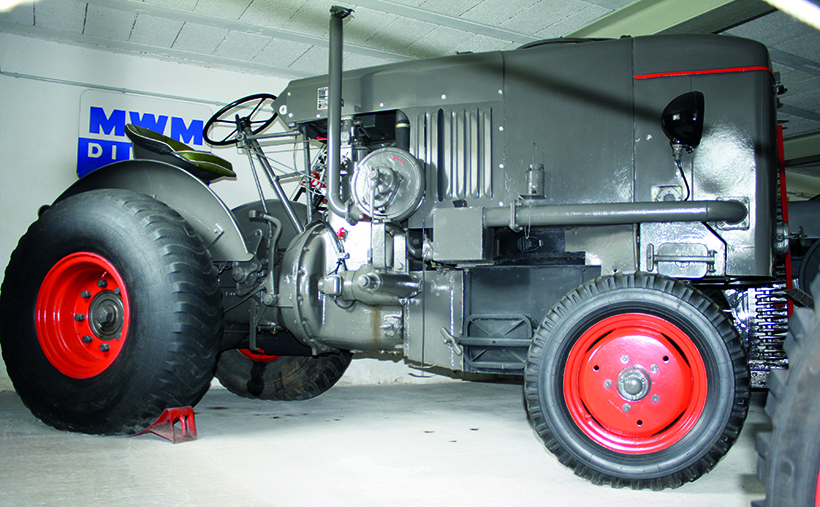
Wood-fuelled tractors: Germany’s EG60 gas generator was included in the design of Fendt G-25 tractors built during the war.
Conversion kits allowing the creation of wood-fuelled tractors appeared briefly in Europe during the final stages of the First World War, when there was an acute shortage of petrol and paraffin.
The idea apparently started in France, attracted little interest but was revived in the late 1930s, as the approach of the Second World War threatened further shortages of oil-based fuels. By the end of that war, many thousands of tractors in mainland Europe – plus a small number in the UK and as far afield as Australia – were equipped for turning wood into fuel.
The process for using wood as engine fuel starts with a process that’s similar to burning logs in an open fire. When wood is heated, it releases a gas that burns if it mixes with oxygen in the air, and this generates heat that produces more of the flammable gas.
Gas production to fuel a tractor takes place in a large container with two sections, including a small compartment in the base where a wood fire generates heat. The much larger, upper section contains small blocks of wood which are heated to temperatures of 700°C or more by the fire below, and it’s the heating process that releases a flow of gas. As the upper section is enclosed to exclude oxygen, the gas doesn’t burn and, instead, it goes to the engine’s combustion chambers where it fuels the engine to power the tractor.
Producer gas
The flammable gas generated from the heated wood is called ‘producer gas’, and consists mainly of nitrogen, carbon dioxide, carbon monoxide and small amounts of hydrogen. Although it can be generated from a variety of materials, including coal, coke and charcoal, the obvious choice to power tractors is the wood that’s available on almost every farm. The gas has been used commercially in industrial processes for about 200 years, and there are still some, mainly small-scale installations operating in countries where supplies of other fuels are limited or expensive.
Although French farmers pioneered the introduction of wood-fuelled tractors, it was Germany that took the lead in developing improved technology for the switch to producer gas for tractors in the Second World War. As wartime approached, German officials realised that fuel shortages could become a major problem affecting food supplies, and that producer gas could have an important part to play. A government-sponsored research project introduced several design improvements to boost the efficiency of fuel production from wood. The result was the EG60 generator; the most advanced equipment of its kind. During the war, as Germany’s fuel situation deteriorated, new regulations specified manufacturers must fit an EG60 generator on every new tractor.

A Renault AFMH series tracklayer pictured in 1943 with a producer gas kit.
One key factor for success with a producer gas generator was the quality of the wood used. Conifer wood was not recommended, and hardwoods were preferred, with beech at the top of the list in Germany. What’s more, the wood needed to be seasoned and kept in dry storage to achieve the moisture content target of 15% or less. In addition, the wood used in gas generators had to be cut into small blocks, and the preferred size for the EG60 was approximately 7cm.
Practical drawbacks
Tractors powered by producer gas contributed substantially to wartime food production, and using home-grown fuel supplies should have brought significant cost savings. But, in practice, some disadvantages reduced the generators’ popularity. One drawback was reduced efficiency compared to oil-based fuels, which resulted in a power loss amounting to 15% or more when used in spark-ignition or semi-diesel engines.
The time-consuming maintenance routine was also unpopular, which began with a 15-20-minute routine at the start of the day, that involved emptying the ashes and embers from the previous day’s fire, preparing and lighting a new fire in the generator’s base, putting a fresh supply of wood in the upper chamber, then waiting until sufficient heat was available to yield enough gas to run the engine. The fire would probably need an additional fuel supply at intervals of two to three hours while working continuously, and it would also need ash removed from time to time during the working period.
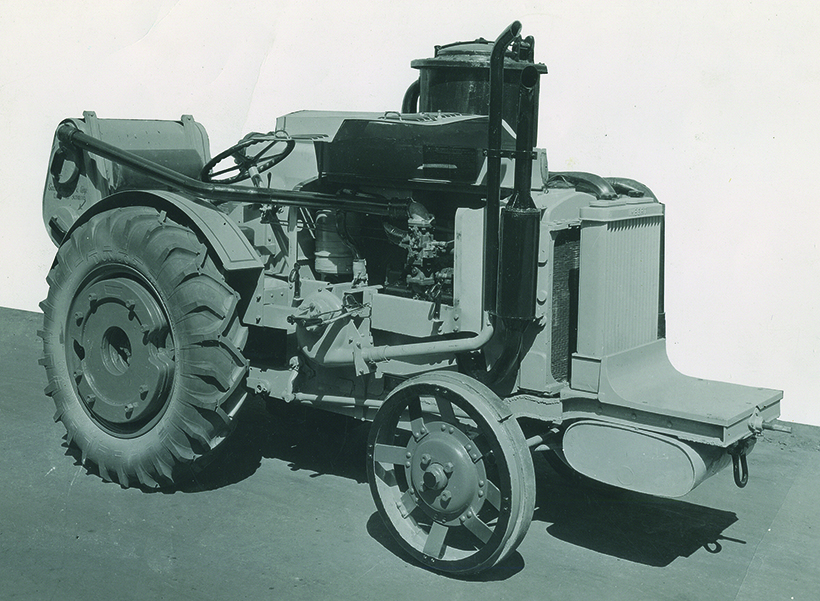
A producer gas version of the 30hp Renault 304H tractor, built in France in 1942.
Some later gas generator designs were more user-friendly, with storage capacity that enabled some gas produced late in the day to be stored, thus speeding up the starting process the following morning. Another option was to mount more than one gas generator on a tractor and, by carefully timing the start time for the second generator, this could reduce the refill delays during the day. An extreme example of this was the triple-generator version available in small numbers during the 1930s on Australian-built Ronaldson-Tippett tractors, allowing producer gas to be used instead of petrol or paraffin at a time when many farmers were facing financial difficulties during the economic downturn.
Blind-spot
Other objections included the large size of the gas generator units. They were usually mounted on the side of the tractor, making the increased overall width a disadvantage while travelling on public roads. Their bulk also created a large blind-spot in the driver’s all-round visibility. One advantage of the German EG60 generator was its more compact size, and the Fendt company incorporated it less obtrusively into the design of its G-25 tractor. Another gas fuel disadvantage was the care needed when emptying hot ashes and glowing embers from the fire while the tractor was working in a field with hay or straw.

Mounting three gas generators helped to reduce the output from this Australian-built Ronaldson-Tippett tractor.
Because of the disadvantages of using wood-based fuel for their tractors, most owners were apparently eager to return to conventional fuels, and producer gas kits were removed as soon as possible after the war, when normal fuel supplies became readily available again. This was easy for kits that had been designed as external attachments to existing tractors, and one result of this is that tractors that have survived with the kits fitted are now uncommon. The G-25 tractor made during the war by Fendt was different because the EG60 generator was an integral part of the design, therefore difficult to remove. Consequently, a few of these models have survived and are now highly valued by enthusiasts in Germany.
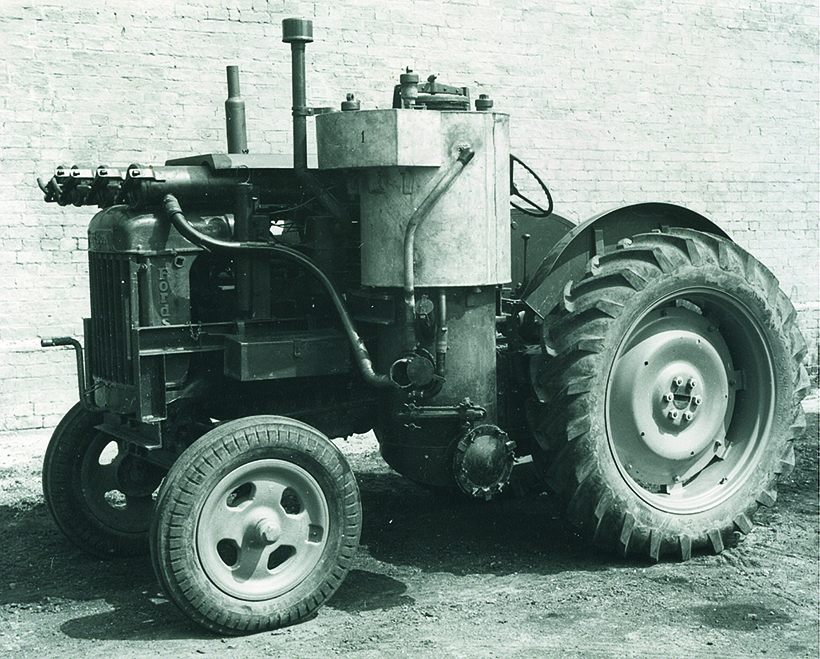
This experimental, British gas generator, mounted on a Fordson E27N, was tested in 1948.
Diminishing interest
Alternative fuel activity in Britain during the war included a brief surge in using methane gas for road vehicles, buses and trucks, with large containers for carrying the gas becoming a familiar sight in some areas. But there was little interest in producer gas for tractors. In an official project involving the National Institute of Agricultural Engineering, an experimental gas generator was developed and tested on a Fordson E27N tractor in about 1948, but interest in producer gas was already fading rapidly by that point.
Since the 1940s, there’s been little commercial interest in fuelling tractors with gas from wood. However, an exception came during the 1980s, when rising oil prices encouraged the development of a new and improved gas generator from the Martezo company in France. It was designed mainly for export to African countries, where fuel costs were becoming a major problem for many farmers, but only a small number were sold.
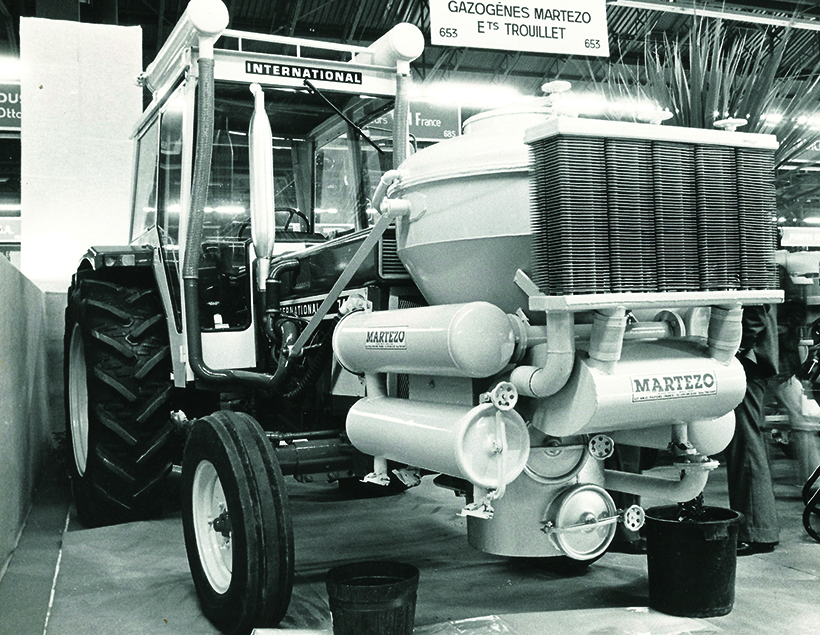
A French-built gas generator on an International tractor, seen at a Paris machinery show in the 1980s.
Although the technology for powering tractors with wood-based fuel has been available for over 100 years, it’s been used only in emergency situations when normal fuels aren’t available, or have become overpriced. Producer gas is still an option for the future, but there are other alternatives such as methane, electric power and crop-derived biodiesel, that could provide a more practical alternative to diesel fuel.
For a money-saving subscription to Tractor & Farming Heritage magazine, simply click here




